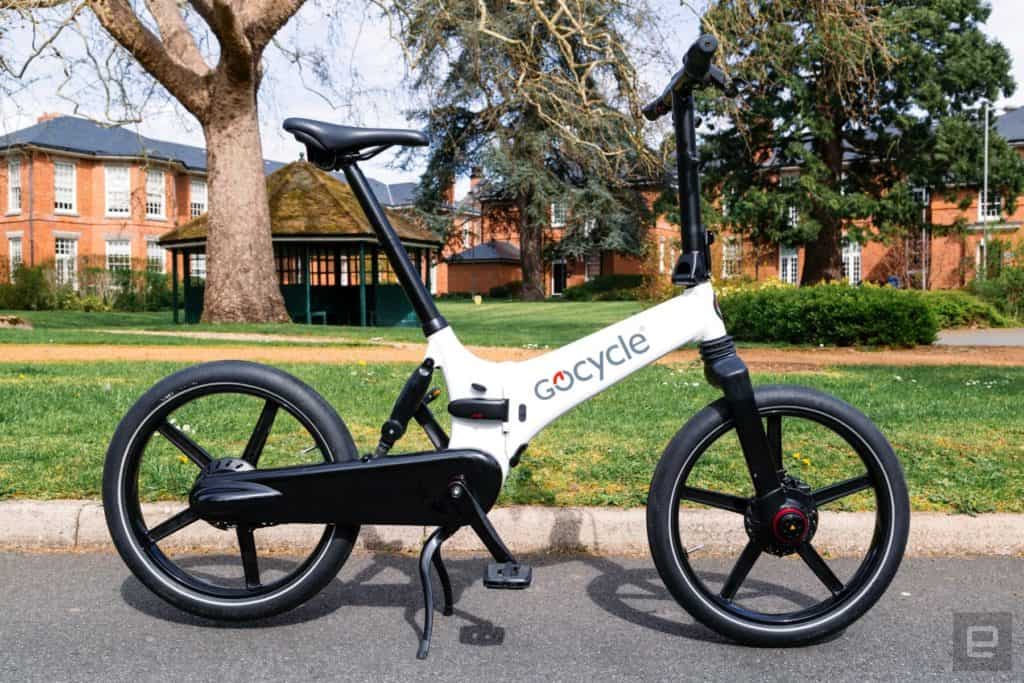
A commuter’s dream.
If you live in a bustling city like London, a folding bike is pretty darn useful. You can take it on a train, taxi or bus — heck, even a Tube carriage if it’s quiet — then disembark and pedal to your final destination. A folding two-wheeler can also be stowed inside your apartment or office, negating the need for hefty locks or built-in location tracking. Across the British Isles, Brompton is the undisputed king of pedal-powered fold-ables. But electric fold-up bicycles? A small company called Gocycle has been making those since 2009 and is arguably the brand to beat at the moment.
On the outskirts of Greater London, I had the chance to ride roughly five miles on the company’s all-new Gocycle GX. From afar, it looks almost identical to its predecessors, the low-end GS and flagship G3. The frame is basically a single bar that runs diagonally up from the crankset. The absence of a top-tube makes it dead-simple to walk up, swing your leg over and start riding, regardless of your stature and what you might be carrying in both hands. It’s an eye-grabbing look that Richard Thorpe, a former design engineer at McLaren Cars, has been refining for more than a decade.
Move closer, however, and you’ll notice a new clasp in the center of the frame. Gocycle has redesigned the folding mechanism and claims the GX can be broken down in under 10 seconds. Unlike the company’s previous models, you don’t have to take the wheels off. You merely flip the switch and fold the frame in half so that both wheels are facing each other. A second clasp brings the handlebars down to the side, next to the front wheel. You’re then able to hold the saddle with your hand and roll the bike along like a suitcase. Alternatively, you can remove the seat post entirely and slip it through a rubbery loop that keeps the folded frame together.
Truthfully, I couldn’t fold or unfold the bike in less than 10 seconds. My times slowly improved, though, and with a little more practice I’m confident that I could do everything in under 15 seconds. That’s fast enough, in my opinion, to not feel like a chore while preparing to leave the house or office. I can imagine some frustrated looks if I spent that long in front of a subway ticket barrier, however. You should probably stop and fold the bike, therefore, in a quiet corner before interacting with the public.
It’s a smart system, though I wonder how long the aforementioned loop will last. The stretchy material is critical to the design and could, I fear, wear out after a few years of daily use. A Gocycle spokesperson told me, however, that the company has stress-tested the folding mechanism and is confident in its durability — for now, I’ll have to take their word for it.
On the road, the GX performs like many other electric bicycles. It has a 500W motor and a top speed of 20MPH, which by law are capped at 250W and 15.5MPH in Europe. (The bike won’t be restricted in the US, where legislation allows “low-speed electric bicycles” with a 750W motor and a 20MPH top speed.) The GX has three manual gears that you switch between with a tradition twist-grip on the right-hand side. The highest of the three is still a fairly low gear, however, so it’s hard to breach the 20MPH ceiling without a steep hill or the ferocity of a Tour de France winner.

The bike has various levels of assist that you can tweak inside the GocycleConnect app. The pre-loaded profiles, such as “City” and “Eco,” are sensible and self-explanatory. I was more interested in the “Custom” tab, however, that lets you build a rider profile from scratch. You can decide when the motor kicks in — specifically, how much power the rider needs to be generating — and the overall strength of the assist. You can set a low power threshold, for instance, to maximise your acceleration at traffic lights. Or, if you fancy a workout, cap the motor assistance for a day.
The GX’s 20-inch wheels are larger than a classic Brompton but smaller than a traditional road bike or downhill beast. I liked the riding position, which is fairly upright thanks to the straight handlebars, and never once felt like I was on a child’s plaything. Gocycles aren’t meant for mountain trails but I appreciated the rear ‘Lockhock’ suspension whenever I bounced off a curb or over a large speed bump. The hydraulic disc brakes were sharp and the manual gear shifter, while basic, was reliable and responsive.
Nestled inside the frame is a 300Wh lithium-ion battery. Gocycle says it will carry you up to 40 miles on a single charge, depending on the terrain and how you’ve set up the assistive motor. From flat, the e-bike takes seven hours to recharge or four with an optional fast charger. The battery is also removable and you can buy spares from Gocycle for £599/$899.
The bike is available to order now for £2,899/$3,299. It sits in-between the entry-level GS (£2,499) and flagship G3 (£3,499), both of which use the older and slower method of disassembly. The G3 is still the top-tier model, however, because it has predictive gear shifting, an adaptive daytime running light on the handlebars, and other ‘smart’ features not found on the mass-market GX. All three bikes, while expensive, are competitively priced with the electric Brompton (£2,595) and folding Hummingbird (£4,495). As always, you need to think of them as car replacements, rather than slightly more powerful bicycles, to justify the steep asking price.


